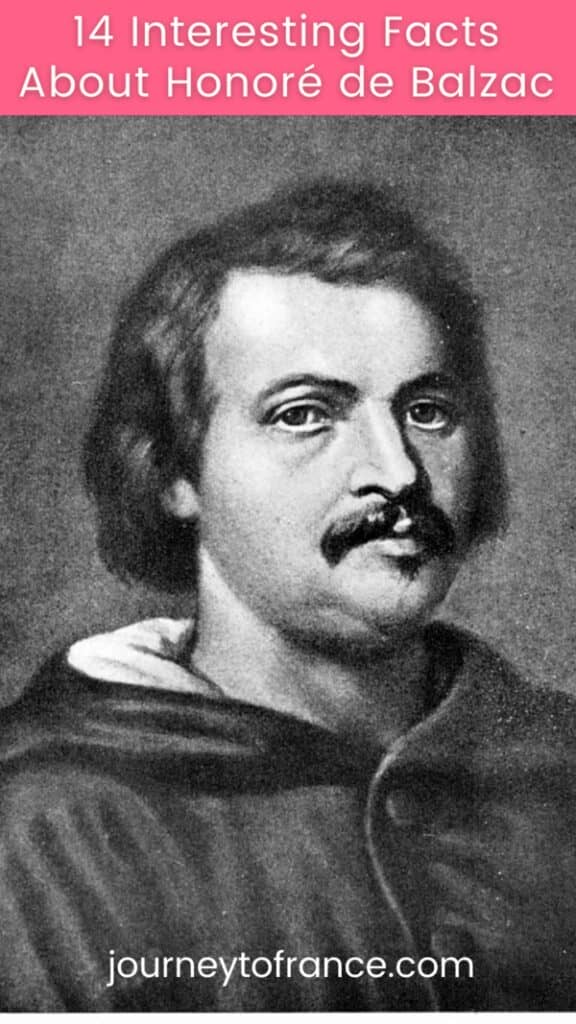Do you want to know some interesting facts about Honoré de Balzac?
Thanks to his keen attention to detail and blunt depiction of society, Honoré de Balzac is widely considered as one of the founding fathers of European realism in the world of literature.
Balzac is praised for the multifaceted characters he invented in his every writing, as even the minor figures in his stories are fully human and complicated.
RELATED READ:
These are seen in his nost notable works, which include La Peau de chagrin (1831; The Magic Skin), Colonel Chabert (1832), Eugénie Grandet (1833), Le Père Goriot (1835), Le Lys dans la vallée (1835; The Lily of the Valley), Illusions perdues (1842; Lost Illusions), La Rabouilleuse (1842; The Black Sheep), Splendeurs et misères des courtisanes (1847; A Harlot High and Low), and La Comédie humaine (1848; The Human Comedy).
All these make Honoré de Balzac one of the most important French novelists and playwrights in all of history.
Scroll for more interesting facts about Honoré de Balzac.
Things you'll find in this article
- 14 Interesting Facts About Honoré de Balzac
- 1. Honoré de Balzac was born Honoré Balssa
- 2. The marriage of Honoré de Balzac’s parents was arranged
- 3. Honoré de Balzac was named after St. Honoré of Amiens
- 4. Balzac’s book Le Lys dans la vallée features a horrible governess based on his own caregiver
- 5. Balzac didn’t do well in grammar school
- 6. Like his father, Honoré also changed his name
- 7. Honoré Balzac published the first novel under his own name in 1829
- 8. Balzac was a caffeine addict
- 9. Balzac was successful in writing, but he failed everywhere else
- 10. Many of Balzac’s books have been adapted into movies and television
- 11. His magnum opus, La Comédie humaine, consists of 91 novels and short stories
- 12. He was the main precursor of realism in European literature
- 13. There is only one known picture of Honoré de Balzac
- 14. He died just five months after marrying his long-time lover
14 Interesting Facts About Honoré de Balzac

1. Honoré de Balzac was born Honoré Balssa
Honoré de Balzac’s father, Bernard-François Balssa, changed his name to Francois Balzac to make it sound more aristocratic.
Francois started off poor. Born to a large family in Tarn in the south of France, he moved to the French capital in 1760 with a purpose of boosting his social status. He succeeded. By 1776, he was already a Freemason and Secretary to the King’s Council.
The older Balzac was a bit of a social climber and wanted to be one of those noblemen he now mingled with.
2. The marriage of Honoré de Balzac’s parents was arranged

Honoré de Balzac’s father Francois married Anne-Charlotte-Laure Sallambier, a wealthy Parisian family’s daughter, who was a lot younger. Their age gap was 32 years; he was 50 and she was 18.
The marriage was fixed, done in gratitude for Francois’ help to the Sallambiers.
3. Honoré de Balzac was named after St. Honoré of Amiens
Honoré de Balzac was born in Tours, France, on the 20th of May in 1799, a few days after the feast of day of St. Honoré which falls on the 16th of May. This name was the idea of Balzac’s father.
St. Honoré is also known as St. Honoratus of Amiens, or St. Honorius. He was the 7th bishop of Amiens in the north of France in the 7th century and is widely regarded as the patron saint of bakers and pastry chefs.
4. Balzac’s book Le Lys dans la vallée features a horrible governess based on his own caregiver
Growing up at a distance from their parents, Balzac and his siblings were raised by wet nurses and governesses. This had a significant effect on Honoré.
In 1835, Honoré de Balzac published a book called Le Lys dans la vallée, where he wrote about a bad governess named Miss Caroline, who is based on the author’s own governess.
5. Balzac didn’t do well in grammar school

As a student in grammar school, Honoré de Balzac had trouble adjusting to the teaching style and was therefore sent by his parents to a boarding school, where he became a troublemaker and frequently got detained.
However, the young Balzac saw these detentions as a blessing as it provided him time to do his favorite thing: reading books.
6. Like his father, Honoré also changed his name
From “Balssa,” the family name became “Balzac.” Honoré also changed it later, adding “de” to denote noble origins. This, however, was not recognized officially.
The reason for this change of name was similar to that of his father’s before him: to better fit into the French aristocratic society.
7. Honoré Balzac published the first novel under his own name in 1829
Les Chouans by Honoré Balzac was published in 1829. It was his first entry to a career-defining masterpiece as it became a series of cross-over stories portraying different faces of French life in the periods of Restoration and July Monarchy (around 1815 through 1848).
His next novel, El Verdugo, however, was published under his new name – “Honoré de Balzac” that same year.
8. Balzac was a caffeine addict

Honoré de Balzac wrote for 12 to 15 hours in one day. He worked from midnight until around eight and sometimes later the following morning. All this time, he would consume up to 50 cups of black coffee.
As Balzac had always been sickly, this amount of coffee consumption and the hours spent writing had contributed to his even worse health in his later years.
9. Balzac was successful in writing, but he failed everywhere else
Balzac was enterprising. In the late 1820s, he ventured into several businesses, which all failed.
He first delved into the publishing business, with books selling as “waste paper.” It was a miserable flop. He then tried his hands in printing, but his lack of experience and capital brought about his ruin in this venture, leaving him in debt.
He also attempted to become a critic as well as a politician, declaring himself a Legitimist and a supporter of King Charles’ Royal House of Bourbon after the overthrow of Charles X in 1830 during the July Revolution.
He never achieved success from any of these ventures.
10. Many of Balzac’s books have been adapted into movies and television

Balzac is a significant figure in popular culture, with many of his books being adapted into movies and TV series. Some of these are the 1915 Travers Vale’s Père Goriot and the 1947 Les Chouans.
Some of his books that were made into mini-series include Le Père Goriot, which was shown on BBC in 1968, and La Cousine Bette that aired in 1974.
11. His magnum opus, La Comédie humaine, consists of 91 novels and short stories
La Comédie humaine, which is translated to English as The Human Comedy, is made up of 91 complete novels and short stories – and 46 unfinished ones.
This multi-volume collection of cross-over novels and tales depicts the French society during the Restoration and July Monarchy periods in the first half of the 19th century.
In La Comédie humaine, Balzac portrays over 2,000 characters, many of whom have recurring roles in the series.
12. He was the main precursor of realism in European literature
This feat was achieved through his works in La Comédie humaine, which, as a whole, was a successful attempt to depict a very detailed portrait of the full range of France’s society back in the day.
Today he is widely considered as the father of European realism in literature.
13. There is only one known picture of Honoré de Balzac

It was a daguerreotype photograph taken by Louis-Auguste Bisson in 1842. Bisson retouched and reprinted it, and later Gaspard-Félix Tournachon, famously known as Nadar, did the same.
Balzac himself told Nadar that the rarity of his photographic images was due to what he called a “vague dread.”
14. He died just five months after marrying his long-time lover
In 1850, Honoré de Balzac married his long-time lover, a Polish aristocrat named Ewelina Hańska. She was married to a wealthy landowner when she started correspondence with Balzac in 1832, meeting him for the first time the following year in Switzerland.
Her first husband died in 1841 and on March 14, 1850, she married the French novelist. Balzac died on August 18 the same year, just five months after the wedding.

Hi, I’m Christine – a full-time traveler and career woman. Although I’m from the Philippines, my location independent career took me to over 40 countries and lived in 4 continents in the last 10 years, including France. A self-proclaimed Francophile, I love everything France.
